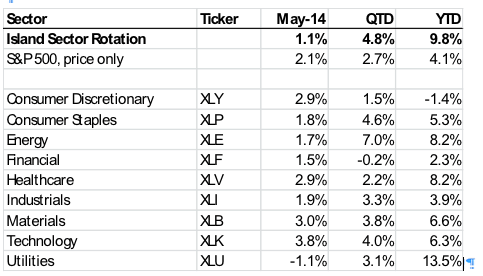 Author: Charles Sizemore
Author: Charles Sizemore
Covestor models: Sizemore Investment Letter and Tactical ETF
Disclosure: At time of writing, short gold via long position in DZZ
The market continues to be volatile in the first week of September, as mildly worse-than-expected economic news caused investors to stampede for the exits. In response to the news — or perhaps in response to the plunge in stock prices themselves — the price of gold has risen to within striking distance of new all-time high and bond yields are hitting a new all-time low.
You read that correctly. The 10-year Treasury note finished the week (9/2/11) at a yield of just 2% approximately (source: Treasury website, retrieved 9/8/11 http://www.treasury.gov/resource-center/data-chart-center/interest-rates/Pages/TextView.aspx?data=yield). Yes, these are the same U.S. Treasury notes that were downgraded by Standard & Poor’s just weeks ago.
As the market was melting down in August, I advised readers to embrace their inner Spock and look at their investments rationally. (“Embrace Your Inner Spock During the Chaos and Focus on Logic, Not Emotions” Charles Sizemore, InvestorPlace 8/9/11 http://www.investorplace.com/2011/08/embrace-your-inner-spock-during-the-chaos-and-focus-on-logic-not-emotions/) It’s hard to keep your cool and stay composed when the world around you appears to have gone mad. But as investors, that is exactly what we need to do.
The U.S. economy may very well be slipping back into recession, as we continue to see no real sign of improvement in employment or in the health of the housing market. And if the markets are indeed sending the right signals, Europe’s sovereign debt crisis may very well be entering a dangerous new phase. But investors who run to bonds and gold are likely setting themselves up for a nasty reckoning.
Let’s start with Treasuries. I don’t believe there is a “bubble” in Treasury securities, per se, as there is a clear limit as to how low yields can go. They can’t go below zero, of course, though they have gotten a lot closer than anyone thought possible. (See my 8/24/10 article “Is There a Bubble in Bonds?” for a longer explanation: for a longer explanation.)
Ever since the crisis began in 2008, bond bears feared that Federal Reserve stimulus and congressional deficit spending would cause yields to soar. It would be the 1970s all over again, minus the shag carpet. Yet three years into the crisis, yields just hit a new all-time low. What gives?
The bond bears failed to appreciate the effects of deleveraging and deflation that follow the bursting of credit bubbles. Had they looked across the Pacific at the example of Japan, they might have been better prepared. Fully 20 years after the bursting of the Japanese bubble, yields on the 10-year Japanese government bond are still far below even current U.S. Treasury yields.
I don’t believe that Americans will ever see yields that low. The United States lacks the trade surplus and high domestic savings rates that helped to sustain the sub-2% rates that have persisted in Japan for so long. Still, we’re not likely to see 1970s yields of 15% or more either. My best estimate of the “proper” rate is something in the ballpark of 3-4%.
When the current sense of crisis abates, yields should climb back into this range. Sizemore Capital may decide to initiate a short position in 7-10-Year Treasuries if market conditions warrant.
While Treasuries may not technically be in a bubble, gold almost certainly is. Bubbles are driven by excessive greed and panics are driven by excessive fear, yet the current rally in gold appears to be driven by a strange concoction of both.
John Maynard Keynes is not a very popular historical economist in this era of Tea Party angst, but Keynes did have one particularly insightful quote about how stock market speculation works. In his General Theory of Employment Interest and Money (1936), Keynes compared the stock market to a newspaper beauty contest in which readers are asked to choose the most beautiful girl from a selection of photos. The readers who picked the most popular face would win. As Keynes noted:
It is not a case of choosing those that, to the best of one’s judgment, are really the prettiest, nor even those that average opinion genuinely thinks the prettiest. We have reached the third degree where we devote our intelligences to anticipating what average opinion expects the average opinion to be. And there are some, I believe, who practice the fourth, fifth and higher degrees.
This is more or less where we are with gold. Investors buy gold not necessarily because they are afraid about the global economy but rather because they are afraid of other investors becoming afraid. Where does this nonsense end? No one knows. Gold first appeared to be irrationally priced to me at $1,200, and it’s risen by approximately 50% since (as of 9/1/11). But then, in the late 1990s the Nasdaq looked awfully expensive at 3,000 and it soared well above 5,000 before finally crashing.
In the closing days of August, Sizemore Capital initiated a small short position in gold for our Tactical ETF model using the PowerShares DB Gold Double Short ETN (NYSE: DZZ). I am well aware of the risks involved in shorting an asset that is the center of a speculative bubble. For this reason, we intend to liquidate the position if gold pushes through to new all-time highs. While I see strong potential in shorting gold at current prices, risk management is an absolute necessity.
Meanwhile, in the much unloved stock market there are some real values to be had. In cold, hard cash dividends, the Dow now yields considerably more than the 10-Year Treasury, and the S&P 500 isn’t far behind. And unlike Treasury interest, those dividends will likely grow with time. U.S. companies are also sitting on record amounts of cash and, outside of the banking sector, have remarkably little debt. Recession or no recession, there are real bargains to be had, and Sizemore Capital intends to maintain its large allocations to quality, dividend-paying American and European equities.
In the immortal words of Warren Buffett, investment success comes from being fearful when others are greedy and being greedy when others are fearful. Today, this means embracing the volatility, avoiding the herd mentality in gold and Treasuries, and maintaining a large allocation to dividend-paying blue chips.



